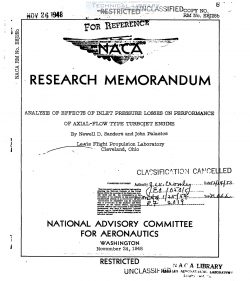naca-rm-e8j25b
- Version
- 41 Downloads
- 1.09 MB File Size
- 1 File Count
- April 21, 2017 Create Date
- April 21, 2017 Last Updated
National Advisory Committee for Aeronautics, Research Memorandum - Analysis of Effects of Inlet Pressure Losses on Performance of Axial Flow Type Turbojet Engine

The experimentally determined performance characteristics of
an axial-flow turboJet engine have been used to estimte the
effects of inlet total-pressure losses on. net thrust and specific
fuel consumption at a constant engine speed.
At low altitudes and flight Mach mmbers, inlet pressure
losses cause an increase in engine discharge temperature and it is
possible that the memmum allowable turbine temperature may be
exceeded. An inlet absolute total—presume loss of 10 percent
will result in a thrust loss of 14 percent and a 15-percent
increase in specific fuel consumption based. on net thrust.
At h1g1 altitudes and flight inch numbers, choking conditions
exist in the emaust nozzle and the inlet pressure losses do not
affect the discharge temperatures. tinder these conditions, a
10-percent loss in inlet absolute total pressure produces a
22-percent loss in net thrust and a 16—percent increase in specific
fuel consumption.
If the exhaust-nozzle-outlet area is adjusted to compensate
for the effect of inlet losses on. discharge temperature in the
noncholcing cases (low altitudes and Mach numbers) , the thrust and
fuel consumption will be changed in a nanner similar to the results
obtained in the choking cases.
The losses in the inlet air ducts, the diffusers, and the
de-icing equipment associated with turbojet engine installations
cause a reduction in the total pressure at the inlet of the engine
and result in reduced thrust and increased specific fuel consumption.
An analytical evaluation of the effects of inlet losses on
the net “Hamlet and the fuel economy of an azial-flow-coressor
WPG turboaet engine with a two-stage turbine is presented. herein.
The analysis is based on engine performance characteristics
that were detemned from experiments in the NAGA Cleveland. alti-
tude wind tunnel (references 1 mg). ‘Jhe experimentalinvestiga-
tion did not include tests in which inlet losses were systematically
varied, but the effects of these losses can be accurately estimated
from the experimentally determined performance characteristics of
the engine.
| File | Action |
|---|---|
| naca-rm-e8j25b Analysis of Effects of Inlet Pressure Losses on Performance of Axial Flow Type Turbojet Engine.pdf | Download |

Comment On This Post